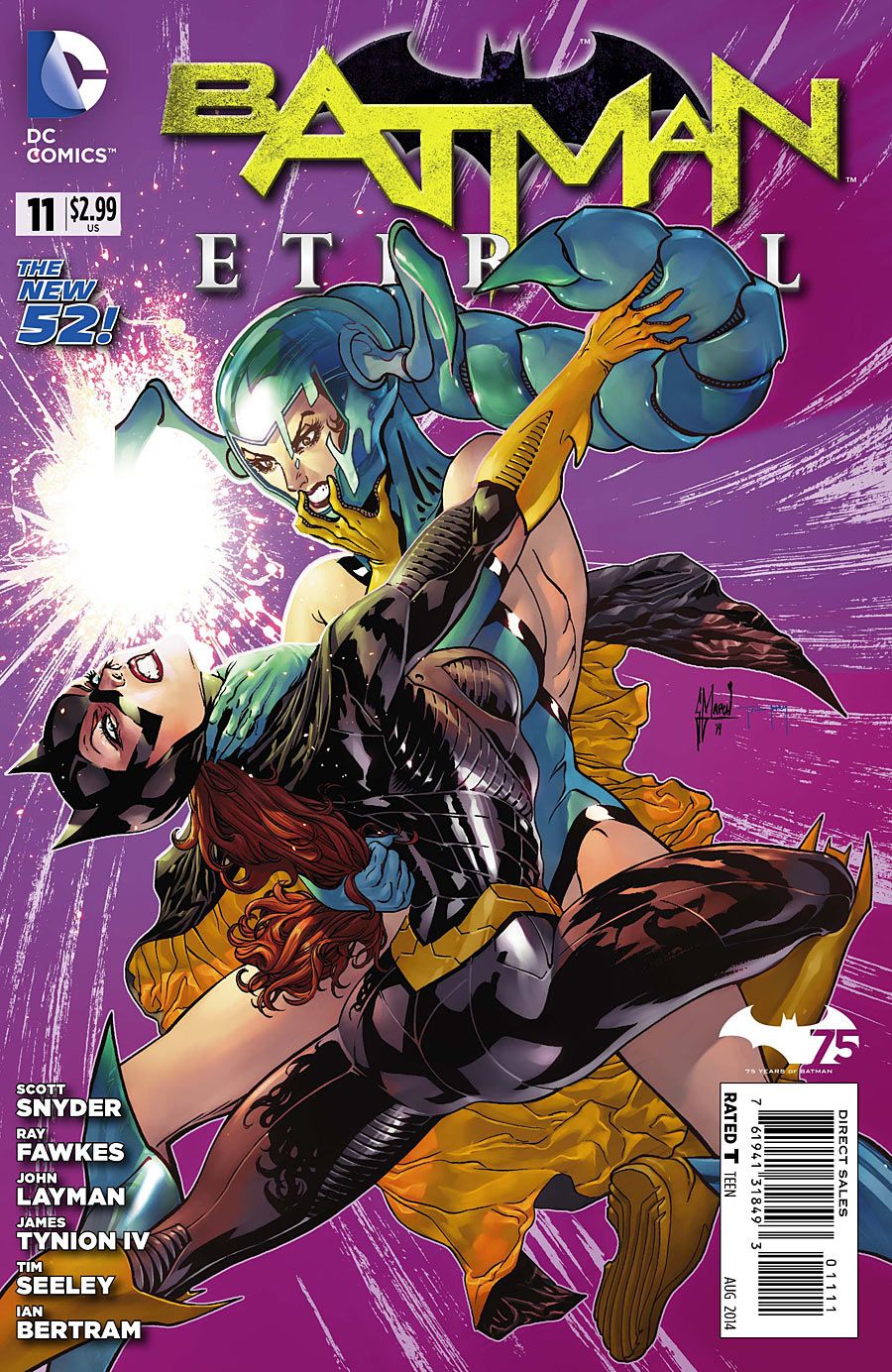In "Batman Eternal" #11, Scott Snyder, James Tynion IV, Tim Seeley and Ian Bertram combine action in Brazil and Daddy issues for the "Day of the Dads."
"Batman Eternal" #11 has a dramatic change in artwork. Bertram's work is strong and distinctive, and in terms of originality and innovation, he's ahead of his predecessors. However, he's an odd editorial choice. The shift feels abrupt and even distracting, even though Bertram's style adds atmosphere and tone. It's not that Bertram is just wrong for drawing a "Batman" story, but slotting him in like this for a weekly, when his style is not at all interchangeable, is only going to throw off readers who will feel that he is ill-suited to the material because his work viscerally alters the experience of the existing story. Similarly, the introduction of several other characters, such as Scorpiana, El Gaucho and Red Hood feels disorienting. While it's fun to see them, the plot already feels like it has too many balls in play.
Bertram's has a strong sense of design and his style also has a lot of fine linework and texture, which makes the entire issue feel tenser. Stewart does superb and delicate work, enhancing Bertram's linework and background details and coloring each scene in a different palette. However, the combined effect is so unlike the visuals of previous "Batman Eternal" issues that it feels unreal.
It doesn't help that the script is weaker for this issue, due to the shoehorning of characters into the conceit of the Father's Day theme. "Batman Eternal" feels like a TV show with its huge cast and pacing. The script goes back and forth among four separate groups of characters: Catwoman at a cemetery in Gotham, Batgirl in Brazil, Alfred and Julia at Wayne Manor, and Stephanie at the library. There are no twists, resolutions or serious revelations in "Batman Eternal" #11. The writing team makes several incremental moves, but it doesn't add up to anything big in the end. This is particularly true for the Scorpiana vs. Batgirl tussle, which has a lot of pretty fight sequences and jokes about male celebrity, but it's all flavor and no fiber. The reader knows that she's doing this for Jim Gordon, but the action still lacks focus.
The Catwoman scene is brief but bookends the issue. It's overdone, coming off as sentimental and melodramatic. Unfortunately, in the New 52 universe, writers have played up the "Bad Girl" aspects of the character in a superficial way, without emphasizing the mental coyness and physical elegance that she previously possessed. Bertram's art and Stewart's green-gray colors give the events a quirky Goth feel that lightens the angst. It's nice to see Selina out of the cleavage-heavy costume, too. Even so, picking up this part of Selina's story feels contrived. It's clearly just so that she can participate in the title pun of the "Day of the Dads." The same goes for Julia and Alfred Pennyworth's confrontation. While the plot has been building towards it, Julia's outburst is petulant and unsympathetic, and the whole scene is too slight to have emotional depth.
Stephanie Brown's story flows the most naturally out of the previous events. It's also by far the most interesting even though all she does is sit in a library. Ironically, considering their ages, her response is more mature than Julia Pennyworth's. Seeley's narration from Stephanie's has natural-feeling and smooth-flowing prose. The nightmare-Batman that Stephanie remembers seeing is a daring and beautiful panel. Even though her situation is outrageous - she discovers that dear Dad is a supervillain and now he's trying to kill her - Seeley makes her situation completely relatable, framing it as a classic coming of age complete with a teenager's scorn. Stephanie armchair-analyzes Cluemaster, variously embarrassed and disappointed by her dad's uncoolness and failures. Yet Seeley's dialogue and Bertram's body language also make the reader feel how she's saddened by her own judgments and newfound clarity of truth. She's grieving her loss, as Bertram's skinny last panel makes clear. It's too bad all of "Batman Eternal" #11 wasn't written with this kind of eloquence, but one hopes that the creative team can devote more attention to developing more of this kind of characterization in future issues.

